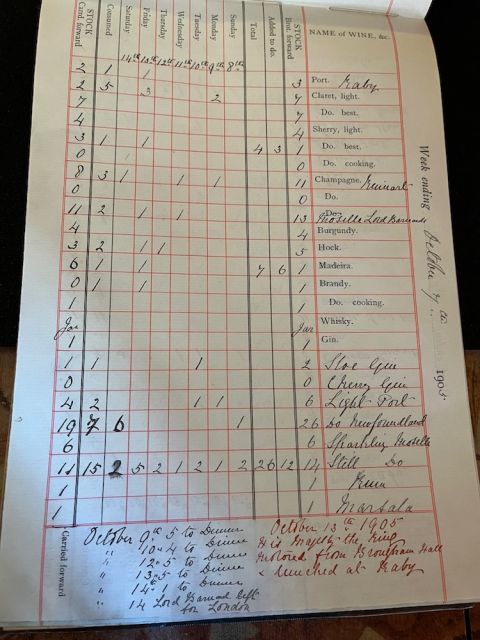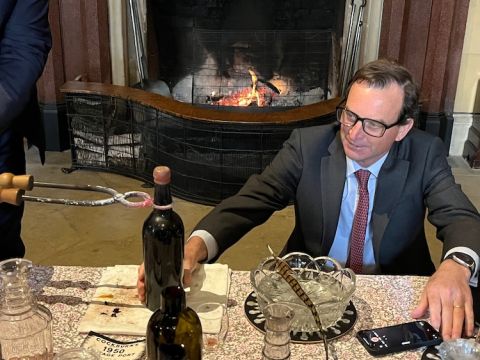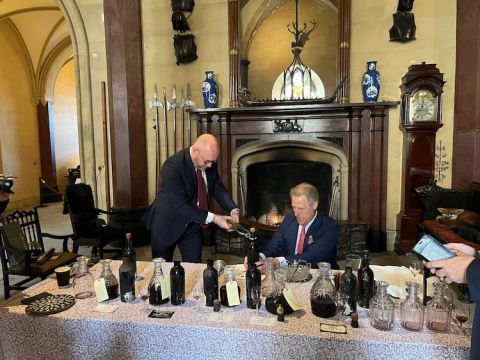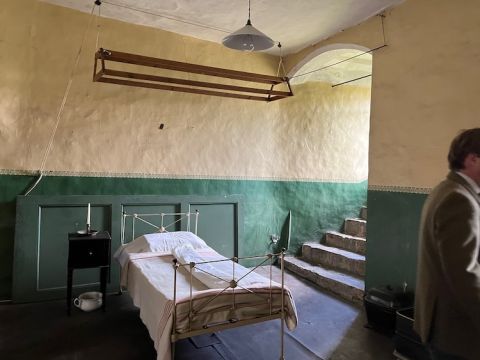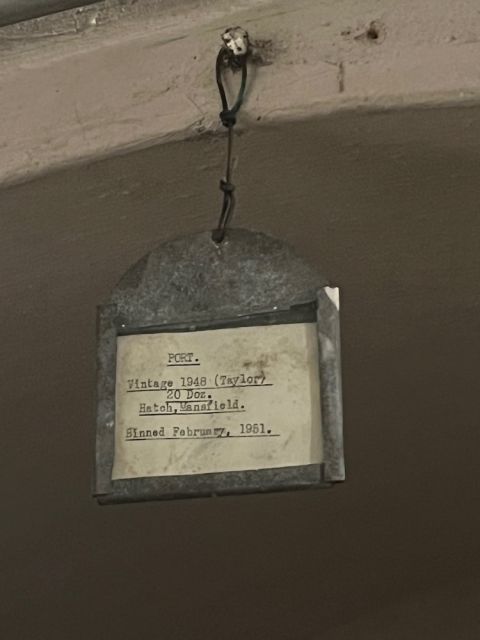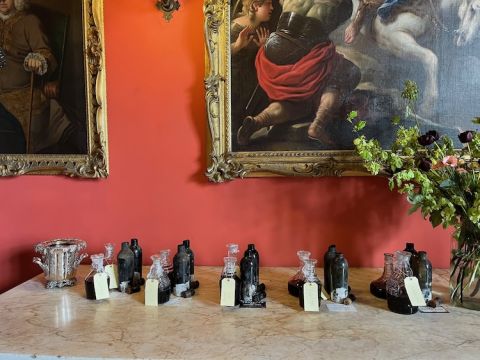A vintage port treasure trove
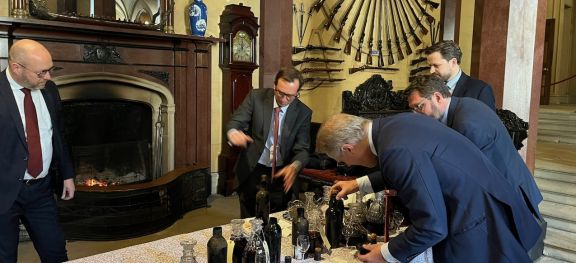
In the north-east of England, 754 bottles of ancient vintage port have been uncovered and are to be offered for sale. A slightly shorter version of this article is published by the Financial Times.
At the end of my most recent article about starting a wine collection on a budget, the one about Spain and Portugal, I suggested laying down cases of port for newborns.
After writing it I came across someone whose father had done just that for his grandchildren and whose appreciation of the multi-case gift has been severely dented by the subsequent storage charges. Professional storage facilities may charge only about £15 a case a year but with a wine as long-term as vintage port, one that demands to be kept for several decades before it shows what it’s capable of, it all adds up.
The answer perhaps is to have your own medieval castle with nice, cool, dark cellars. This was the happy position Lord and Lady Barnard found themselves in when they inherited Raby Castle in the far north-east of England in 2016. The castle is basically a succession of towers and additions from different periods, each one domesticated by a different generation, so that today it is rabbit warren of more than 100 rooms in varying stages of decay. The building is so rambling that presumably it took the current Barnards some time to discover that in the castle cellars were stone bins full of vintage port, undisturbed for up to a century.
The port had been bought by Lord Barnard’s predecessors to provide stirrup cups whenever they went hunting. They must have hunted a lot. When the Barnards, or rather Christie’s wine people, whom they called in to sell the port, examined the collection in detail they found a total of 754 bottles, from 1950 back to 1924. And from a port lover’s point of view, it was extraordinary that the very finest vintages remained: Taylor’s 1948, Fonseca 1934, Dow’s 1927, Dow’s 1924 – and Cockburn 1950, a spotty adolescent in vintage port terms.
The beautifully kept cellar books show the consumption of each bottle from the early years of the last century to the 1960s, after which the vintage-port collection seems to have been ignored. So all the 1908s and 1912s have been drunk, alas, and an earlier Barnard had already started on the 1924s, so a mere 36 bottles of this classic wine remain. But there are 200 bottles of the equally rare Fonseca 1934, which was for me the most outstanding wine of the lot when I attended a lunch at Raby Castle in late April to taste the ports.
I arrived from London, via Darlington station, to find Adrian Bridge, CEO of The Fladgate Partnership that now owns Fonseca as well as Taylor’s, and Charles Symington (seen above), head winemaker for Symington Family Estates, busy opening two bottles of each of these venerable wines, so much older than most wines I get to taste. The incomers from Oporto were at a table in front of Castle Raby’s vast fireplace in the rifle-bedecked great hall, overlooked by an alarmingly lifelike stuffed fox. They were busy applying port tongs, heated in the fire until they glowed, to the necks of the bottles so that with any luck they cracked neatly. By these men at work was a bowl of iced water cooling the pheasant feathers used to wipe the bottlenecks to make them even more likely to crack after the shock of the tongs. (Corkscrews would struggle with corks deliberately designed to stay in place for so many decades because they tend to splay out into the neck of the bottle.)
Edwin Vos (seen above with Adrian Bridge, who is seated at the decanting table) and Noah May of Christie’s were in attendance as well as some notable port enthusiasts, and specialists such as fellow wine writer Richard Mayson, author of the Port Vintages compendium Julian Wiseman, and Alex Bridgeman, organiser of the BFT, an annual professional showing of fortified wines in London.
We were rather loth to leave these 10 decanters of some of the rarest ports in the world but Lady Barnard, a force of nature, was determined to take us on a whistlestop tour of the castle before lunch. It did indeed prove eye-opening (not least in the austerity of a maid’s bedroom in the basement – see below) and culminated in the cellar.
It had clearly been a port-dominated wine collection, although now all that remained in the port bins were the typed labels hanging above them.
A few bottles of ancient St-Émilion were left in one bin; three dusty bottles of Gordon’s gin in another. The St-Émilion labels were too dusty to read during our rapid visit but I assume the Christie’s staff would have liberated them had the bottles been valuable.
The dining room to which we ascended was predictably handsome, and when we all sat down and started talking, the most extraordinary coincidence emerged. That very day, 25 April, was the 50th anniversary of Portugal’s famous Carnation Revolution, which saw the downfall of the previous authoritarian regime. The reason the date had been chosen back in January had nothing to do with history; it was just conveniently close to the date that Adrian Bridge had to come to the UK for a board meeting, and to attend both the BFT and the annual Wine & Spirit Education Trust graduation ceremony on the 23rd. He suggested to Edwin Vos in an email, ‘we can probably find a mouthwash of an old tawny to set us up for the vintage ports’, and he decided, again coincidentally, to provide Taylor’s 50 Year Old Tawny Port. Charles Symington, who didn’t know what Bridge was bringing, and combined his trip with a visit to his daughter at Leeds university, also happened to supply a 50-year-old tawny – Graham’s Single Harvest 1974 Tawny Port – to prepare our palates for the even older vintage ports.
So, after asparagus and a melting fillet of Yorkshire beef, served with some of the table wines that each of these pre-eminent port shippers now make, we sipped these two ‘mouthwashes’ with the apricot tart that preceded the cheeses designed to go with the vintage ports. Symington mused how worried about the future of the port wine trade, or Port Wine Trade as its participants always spell it, his grandfather must have been 50 years ago. Would their entire stocks be requisitioned, he must have wondered.
But now came the moment when the Raby relics, so unusual in not having been moved an inch for decades, were to be tasted, from decanters moved resolutely, as is the custom for port, in a clockwise direction round the table.
Cockburn 1950 has never been a famous vintage port. ‘Rather undistinguished’ is how wine chronicler and founder of Christie’s wine department Michael Broadbent dismissed his most recent tasting of it in his classic Vintage Wine (Little, Brown, 2002). But it served as an excellent entrée to the glories to come.
Taylor’s 1948 is a famous wine. ‘Invariably magnificent’, according to Broadbent. And indeed it was showing extremely well at Raby Castle – if anything, amazingly, its magnificence still tightly wound and the wine yet to reach its peak. It was made in the same year that Fonseca, run by the Guimaraens family, was acquired by the company now known as The Fladgate Partnership. So the glorious Fonseca 1934 would have been made by a member of the Guimaraens family, one of whose descendants, David Guimaraens, is now head winemaker for The Fladgate Partnership. Apples don’t fall far from the tree in the port business.
The Dow ports from the 1920s were each a fully mature joy, made long before any of us was born. The first bottle of Dow’s 1927 was admittedly a little bit tired (as well it might be) but the second was a sweet treat leading to Dow’s signature dry, peppery finish, while the centenarian was even more vivid. Still with a hint of purple in its ruby colour, it was quite incredibly lively and juicy.
As a leading member of the port trade, Adrian Bridge presumably has a fair portion of port in his bloodstream almost permanently but added to an email about how the date of this port extravaganza was fixed: ‘I would have travelled to taste those wines whatever date Edwin chose’.
These vintage ports will be offered for sale by Christie’s online 7–20 June.
Other stunning vintage ports
I gave all these vintage ports, some tasted at Raby Castle, some on other occasions, a perfect score. They are all about 19.5% alcohol. Prices are per bottle. I’m surprised to find so many of them available retail. The Vintage Port Shop in Hampshire, also known as Vintage Wine and Port, is a specialist retailer that will ship anywhere in the world.
Fearon Block 1927
£1,495 The Vintage Port Shop
Fonseca 1934
£2,495 The Vintage Port Shop
Graham’s 1945
£1,140 MWH Wine Merchants, £1,850 The Vintage Port Shop
Taylor’s 1945
£1,795 The Vintage Port Shop
Graham’s 1948
£1,140 L’Assemblage
Taylor’s 1948
£1,295 The Vintage Port Shop
Quinta do Noval, Nacional 1963
£2,880 Hatton & Edwards, £3,500 Tufton Arms Hotel, £4,200 MWH Wine Merchants
Quinta do Noval, Nacional 1997
£910 Hedonism, £1,325 The Vintage Port Shop, £1,600 Millésima UK, £1,865 Berry Bros & Rudd
Quinta do Noval, Nacional 2003
£720 Hatton & Edwards, £840 MWH Wine Merchants, £1,140 Millésima UK
Access to 1,864 tasting notes on port, with scores and suggested drinking dates, is included in membership of JancisRobinson.com. For international stockists, see Wine-Searcher.com.
Become a member to view this article and thousands more!
- 15,408 featured articles
- 275,024 wine reviews
- Maps from The World Atlas of Wine, 8th edition (RRP £50)
- The Oxford Companion to Wine, 5th edition (RRP £50)
- Members’ forum
- 15,408 featured articles
- 275,024 wine reviews
- Maps from The World Atlas of Wine, 8th edition (RRP £50)
- The Oxford Companion to Wine, 5th edition (RRP £50)
- Members’ forum
- 48-hour preview of all scheduled articles
- Commercial use of our wine reviews

